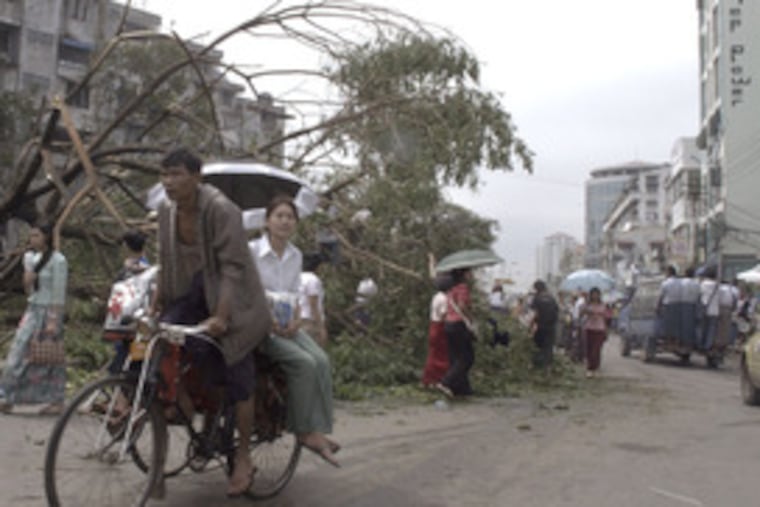Felled by the cyclone
As Myanmar struggles with human toll, Yangon also mourns irreplaceable trees.

YANGON, Myanmar - The waiter looks down at the streets of Yangon from the panoramic rooftop restaurant. He remembers how diners used to be shielded from the noise and bustle of the city below by a thick green cushion of leaves.
When Cyclone Nargis ripped through Myanmar's largest city last month, its 120 m.p.h. winds snapped 100-year-old trees like matchsticks, wiping out much of Yangon's living link to its colonial past.
"There were green canopies covering the roads below. Now, you only see taxis and cars," said the waiter, San Myant Myant, as he stood beside a table on the 20th floor of the Thiripyitsayar Sky Lounge, atop one of the city's tallest buildings.
"There's no green anymore to soften the hues of the city," he said. "How long will it take to grow back all the trees? Perhaps a hundred years."
As Myanmar grapples with the tens of thousands of dead and many more homeless from the May 2-3 cyclone, it is coming to terms with another casualty: the loss of one of Asia's last colonial-era, leafy cities.
The Yangon Municipal Gardens Department said more than 10,000 trees were uprooted across Yangon, including at least 530 that were more than 50 years old.
"The cyclone was a terrible shock to me," said Khin Htway, 83, a retired doctor who has lived her whole life in Yangon. "But to see so many trees that are older than I am uprooted in one fell swoop was devastating. They are irreplaceable."
When the British built this city more than a century ago and named it Rangoon, they lined wide boulevards with stately trees and created leafy suburbs of lakes and gardens.
Towering rain trees, stately mahoganies, banyan and Burmese rosewoods were scattered around Yangon's streets and parks, providing much-needed shade from the sweltering tropical sun.
Banyan trees are sacred to Buddhists, who believe that Buddha attained enlightenment while sitting under one. In Myanmar, the venerable trees are believed to house spirits.
But these top-heavy trees were especially vulnerable to the cyclone's fierce winds, conservationist Aung Din said.
Under British rule, Burma - as the country was then called - was one of the wealthiest in Southeast Asia and the region's biggest producer of timber and rice.
Over the years, much of Myanmar's colonial past was wiped away by the military regimes that have ruled since 1962 and transformed the country into one of the poorest in the world.
The current junta renamed the country Myanmar in 1989 and changed the capital's name to Yangon. In 2005, the junta relocated the capital to the newly built, isolated city of Naypyitaw in the north.
The reclusive generals blocked the outside world's influence and modernity, leaving Yangon with the dusty tranquility of another era. Its leafy charm stood in stark contrast to the traffic-clogged concrete jungles that sprung up in neighboring Southeast Asian capitals such as Bangkok, Jakarta and Manila.
World War II-era buses still ply the streets. Peeling pastel paint hangs from the once-grand facades of neglected but sturdy colonial buildings.
But with the loss of the trees, Yangon is a changed city.
Many residents who visited the grounds of Yangon University after the storm came away in tears. The campus, which was full of stately old trees and was a favorite picnic spot, is now eerily bare.
"We used to sit under the big, shady trees to read and chat," said Tin Moe Hlaing, 29, a master's student in international relations. "I miss doing that."